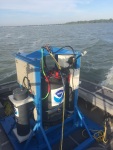With a network of experimental buoys that are constantly recording new data every few minutes, the amount of data the NOAA Great Lakes Environmental Research Laboratory (GLERL) has collected in the past 15 years is massive – and prepping it all to be archived in an official data repository is no small task. This year, thanks to the hard work of GLERL’s data managers and engineers, the Great Lakes environmental data collected by NOAA GLERL’s real-time buoys has been archived with NOAA’s National Centers for Environmental Information (NCEI) data repository. NCEI hosts and provides public access to one of the most significant archives of oceanic, atmospheric and geophysical data in the world.

An ever-growing collection of Great Lakes data
This real-time Great Lakes observational data archived in NCEI has been collected over time by sensors on coastal buoys as part of GLERL’s Real-Time Coastal Observation Network (ReCON). Each of ReCON’s 16 buoy stations collects meteorological data and provides sub-surface measurements of chemical, biological, and physical parameters (things like wave height, dissolved oxygen, chlorophyll, and water temperature). Totaling an impressive 2,055 data files, this data spans 15 years – from the inception of the first ReCON station in 2004 through the end of the 2019 field season. The data collected by GLERL’s ReCON buoys in the past 15 years are unique and valuable, and now that they are properly processed and easily accessible in the NCEI archive, they can be used in a variety of ways.
Using historic data to improve scientific models
While the near real-time info that our experimental ReCON buoys provide is great for helping you decide whether to hit the water for a day of boating or fishing, their usefulness doesn’t stop there. This Great Lakes ReCON data – both old and new – is incredibly useful to state and federal resource managers, educators, and researchers. For example, scientists can use the historic datasets to test the accuracy of their models, a process known as ‘hindcasting.’ When using archived data for hindcasting, researchers enter data for past events into their model to see how well the model’s output matches the known results. One cool example of hindcasting is the animation below that shows the Lake Superior wind and wave conditions that led to the sinking of the Edmund Fitzgerald in 1975.
As for the fact that ReCON data is collected in near real-time, these convenient same-day measurements can help determine whether or not a hypoxic (low oxygen) event will occur, detect nutrients contributing to harmful algal blooms, and even provide crucial data to the NOAA National Weather Service for coastal forecasting.

Putting our data to the test
NOAA GLERL data manager Lacey Mason and marine engineer Ron Muzzi are in charge of preparing and submitting the data to NOAA’s NCEI data repository. Preparing the data to be archived involves performing quality assurance checks to ensure that it meets the Integrated Ocean Observing System’s (IOOS) standards set specifically for real-time oceanographic data. All of the data undergoes multiple quality tests before being archived, and each data point is flagged to indicate its reliability – whether it passed all tests, is suspect, or failed one or more tests.
In addition to being available on NOAA GLERL’s website and now the NOAA NCEI data repository, GLERL’s real-time buoy data can also be found on NOAA’s National Data Buoy Center website. The NCEI archive is fully updated with all of GLERL’s real-time data through 2019, and GLERL will continue to add new data to the archive on a yearly basis. The archived data can be accessed from the link here: https://doi.org/10.25921/jvks-b587.













![drifters map 2 [Converted]-01.png](https://noaaglerl.files.wordpress.com/2016/07/drifters-map-2-converted-011.png)
